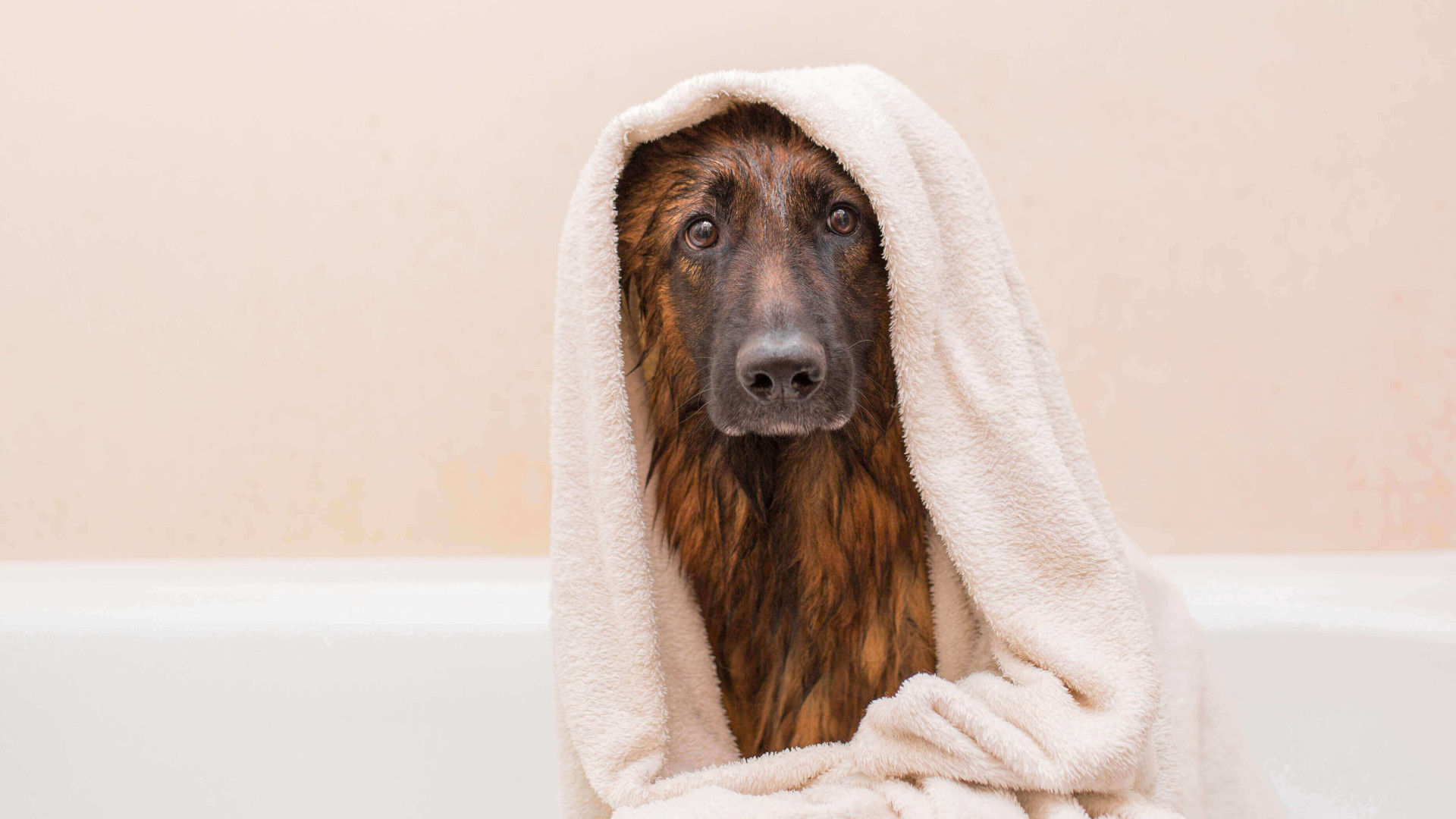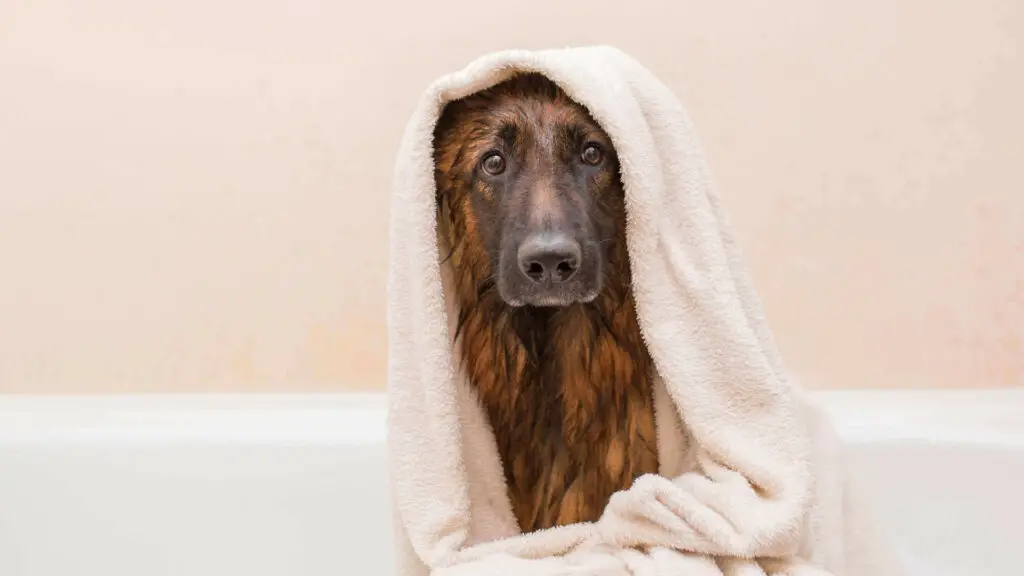How to Give Your Dog a Thorough Washing at Home
How to wash a dog: Giving your dog a bath is an important part of keeping them clean, healthy, and happy. While professional mobile dog grooming or a visit to a dog grooming salon can be useful for more intensive grooming needs, at home dog washing is something every dog owner should know how to do properly. Washing your dog regularly at home will help keep their coat, skin and overall hygiene in great shape. Follow this complete guide to learn the proper techniques, tips and steps for washing your dog at home.

Key Tips for Washing Your Dog at Home – How to wash a dog
Follow these tips for an easier, stress-free bathing experience each time you wash your dog at home:
- Set up a secure washing station with good drainage and non-slip surfaces
- Gather all supplies in advance so they’re within easy reach
- Adjust water to a warm but not hot temperature
- Use treats, praise and calm handling to keep your dog relaxed
- Thoroughly saturate, lather, rinse and repeat if needed
- Take extra care when washing sensitive areas like face, ears, belly
- Rinse extremely well to remove all traces of shampoo
- Towel dry fully, paying special attention to ears, toes and skin folds
- Finish drying with a blow dryer on low heat if needed
- Brush before and after to distribute oils and remove tangles
- Make it a positive experience with rewards and upbeat tone
Regular at home washing keeps your dog’s coat clean, skin healthy and prevents odor. With the right tools and techniques, bathing your dog can be easy and enjoyable for both you and your furry friend.
Gather the Proper Dog Grooming Supplies
Before giving your dog a bath, make sure you have all the necessary dog grooming tools and equipment:
- Dog shampoo and conditioner formulated for your dog’s coat type
- Towels – both for drying and for your dog to stand on
- Non-slip bath mat or towel
- Cotton balls to keep water out of your dog’s ears
- Treats for positive reinforcement
- Brush and comb for detangling – especially important for long fur
- Optional: pet brush, detangling spray for long fur, blow dryer
It’s also a good idea to brush your dog thoroughly before the bath to remove any knots, mats or excess fur. Entangled fur can worsen when wet. Set up your washing station in an easy to clean area like a bathtub, utility sink or outdoors on a non-slip surface. Have all your supplies in reach before getting your dog wet.
Use the Right Temperature Water
Make sure the water is a comfortable warm temperature for your dog. Test the temperature on your wrist – it should be warm but not hot. Sudden splashes of hot water can startle your dog during their bath.
Use Positive Reinforcement
For many dogs, bath time can be a stressful experience. Help your dog feel relaxed by using lots of praise, encouragement and treats throughout the process. Give treats for calm, tolerant behavior in the bathing area before, during and after the bath. This will help create a positive association.
Wash Your Dog Thoroughly
Once your dog is calmly standing in the tub or wash area, use a sprayer or cup to wet their coat from the shoulders down. Avoid getting water in their face at this stage. Apply a generous amount of dog shampoo down the back and use your hands to create a good lather over the entire coat, legs, belly and rear. Gently work the shampoo thoroughly into the fur and skin with your fingers in circular motions. Pay special attention to the paws, belly, armpits and other areas that tend to collect dirt. Let the shampoo sit for 2-3 minutes before rinsing. For the head and face, use a washcloth to gently clean around the eyes, ears and muzzle. Avoid getting shampoo directly in the eyes.
Rinse Completely
Rinse your dog’s coat very thoroughly, using your hands to ensure all traces of shampoo are removed. Any leftover shampoo residue can dry out the skin and cause irritation. Rinse until the water runs completely clear. For long or thick coats, apply conditioner after shampooing and let it soak in for a few minutes before rinsing thoroughly. This helps keep the coat soft, manageable and detangled.
Dry Your Dog Off
Use an absorbent towel or blow dryer on a low heat setting to dry your dog’s fur. Make sure to dry between skin folds where moisture can collect. Pay special attention to drying between the toes and around the ears. Remaining dampness in these areas can lead to infections. Brush out the coat as you dry to remove loose hair and distribute the dog’s natural oils.
Reward Your Dog
Give your dog lots of praise and treats when the bath is finished. This helps reinforce that bath time is a positive experience resulting in rewards. Regularly bathing your dog at home will get easier with practice using positive reinforcement techniques.
Dog Bathing Tips and Tricks
- Limit full baths to once every 3-4 months for most dogs, unless they get especially muddy or dirty between washes. Over-bathing can dry out skin.
- Use a conditioning spray or leave-in conditioner between full baths to help keep your dog’s coat clean, soft and manageable.
- Invest in quality dog shampoo and grooming products suited for your dog’s specific coat type for best results.
- Always thoroughly rinse away all traces of shampoo – residue left behind can cause skin irritation.
- Be extra gentle around sensitive areas like eyes, ears, belly and rear.
- Help your dog feel secure during baths by using a non-slip surface and keeping a hand on them at all times.
- Make sure to dry your dog fully – dampness can allow yeast and bacteria to grow.
- Brush your dog before and after bathing to remove tangles and distribute the coat’s natural oils.
- Use a grooming loop or leash to keep your dog from jumping out of the tub or bathing area.
- Keep sessions positive, calm and rewarding – this will help your dog relax during bath time.
Key Dog Washing Supplies for Home Grooming
Giving your dog a quality washing doesn’t require expensive professional dog grooming tools. There are a few basic supplies that make bath time much easier for both you and your furry friend.
Quality Dog Shampoo
Investing in a good dog shampoo made specifically for your dog’s coat and skin type is the most important supply. Dog shampoo is formulated at a pH level suitable for canine skin and contains ingredients that target issues like dryness, itchiness, odor and excess shedding. Using regular human shampoo can disrupt your dog’s skin pH balance and cause irritation. Choose a reputable brand of dog shampoo suited for your dog’s specific needs.
| Shampoo Type | Best For |
|---|---|
| Oatmeal dog shampoo | Itchy, irritated skin |
| Hypoallergenic or sensitive skin formula | Dogs with allergies or skin sensitivity |
| Shed control shampoo | Heavy shedders |
| Deodorizing shampoo | Smelly coats |
| Brightening shampoo | White or light colored coats |
| Moisturizing shampoo | Dry, flaky skin |
Dog Conditioner
Conditioner helps keep your dog’s coat soft, manageable and detangled by smoothing the hair cuticle. Using a conditioner suited for dogs is especially important if your dog has medium-long, thick or curly fur.
Conditioner should be applied after shampooing and rinsed out thoroughly. Leave-in conditioning sprays can also be used between baths to help keep your dog’s coat detangled and prevent matting, especially in high-friction areas like behind the ears, armpits and between the legs. When shopping for dog conditioner, look for formulas designed for your dog’s specific coat type and needs. For example, a de-tangling conditioner works well for long, thick coats while one with extra moisturizers helps smooth and soften dry, brittle coats.
Dog Drying Towels
A good set of absorbent dog towels helps soak up all that moisture after bath time. Look for large, ultra-absorbent towels made specifically for drying dogs. Having a few on hand ensures you always have a dry one ready for each bath. It’s also helpful to place an absorbent bath towel or mat on the floor of your washing area – both for traction and to soak up drips. A wet, slippery surface can cause anxiety in dogs. Microfiber towels designed for pets dry faster and tend to be more absorbent than regular cotton towels. Some pet parents also use special absorbent dog coats or robes to aid in drying.
Non-Slip Bath Mat
Bath mats or non-slip surfaces keep your dog secure and prevent slips and falls during baths. Dogs feel more confident standing on a grippy, textured surface. Consider putting down a non-slip mat, using a rubber tub mat or placing towels on the floor of your washing space. You can also purchase special non-slip bath tubs just for washing pets. These are elevated, have textured floors and often have ramps or steps for easy entry. Stability is key for a stress-free dog washing experience.
Treats
Treats make the perfect positive reinforcement tool when training your dog to tolerate and accept bath time. Have your dog’s favorite small, soft treats on hand to reward calm behavior and compliance with bathing steps. Proper use of treats helps dogs associate bath time with good things. Make sure to give treats during the process, not just after. Dogs connect rewards most strongly to what they were doing in the moment of receiving the treat. Deliver treats for tolerating handling, letting you wash certain areas, and for general patience.
Brushes
Brushing before and after bathing helps remove tangles, loose hair and evenly distributes your dog’s natural oils after rinsing. Slicker brushes work well for most coat types, while pin brushes help smooth out long coats. Use a wide-tooth comb on areas prone to matting. Regular brushing also helps you spot any parasites like fleas or ticks. Do a full inspection during your pre-bath brushing session. Catching any unwanted pests early prevents them from multiplying.
Optional Extras
- Blow dryer – Helps dry your dog’s coat faster, especially useful for thick or long fur. Use only on low heat settings. Always monitor closely to prevent overheating.
- Detangling spray – Light leave-in conditioners and detanglers allow gentle brushing out of mats and make combing easier. Great for long coats.
- Water sprayer – A hand-held sprayer allows controlled application of water to your dog’s coat instead of dumping water over their head. Easier for dogs nervous about baths.
- Grooming arm – Special arms attach to the side of your tub or sink to hold sprayers in place for hands-free rinsing.
Choosing the Right Dog Shampoo
There are many types of dog shampoo formulated for different needs. Choosing the right one for your pup is important. Here are some things to consider:
- General cleansing – Use a gentle puppy or dog shampoo to clean the coat and skin without irritation. Oatmeal, aloe, and shea butter shampoos can soothe sensitive skin.
- Sensitive skin – Some dogs have skin allergies or conditions requiring special shampoos that are hypoallergenic and fragrance-free. Consult your vet.
- Shedding – Shampoos with vitamins or proteins can reduce shedding by stimulating the fur follicles.
- Fleas/ticks – Medicated shampoos kill fleas, ticks, and flea eggs while cleaning. Use as part of overall flea treatment.
- Deodorizing – Shampoos with baking soda or activated charcoal can help eliminate “doggie odor”.
- Conditioning – Formulas with conditioners add moisture and make brushing easier. Great for dogs with long or tangled coats.
Avoid shampoos made for humans, as the pH isn’t right for dog skin and may cause irritation. Always follow directions for dilution and rinsing.
Bathing Tools & Techniques
Bathe your dog in a tub, sink, or using a hose/sprinkler outside. Small dogs can be washed in a sink or tub. For medium or large dogs, use a bathtub or walk-in shower. Outdoor bathing works for dogs of all sizes if the weather permits.
Indoor bathing
- Use a rubber mat or install a non-slip tub floor for safety.
- Adjust the water to a warm, comfortable temperature.
- Use a detachable spray nozzle to wet and rinse your dog thoroughly.
- Keep liquid soap and shampoo within easy reach.
- Have towels ready nearby.
Outdoor bathing
- Pick a warm, sunny day and a shaded spot in the yard.
- Use a hose with adjustable pressure nozzle.
- Provide good drainage so there’s no standing water.
- Have shampoo and towels accessible.
- Rinse away from storm drains to avoid runoff.
Bathing technique
- Protect eyes and ears from getting water and soap inside.
- Wet your dog’s coat thoroughly, massaging skin to relax them.
- Apply shampoo and work into a thorough lather from head to tail.
- Let shampoo sit for 2-5 minutes before rinsing if medicated.
- Rinse until water runs clear. Repeat if needed.
- Check for any remaining soap residue and rinse again if needed.
- Follow with a conditioning rinse or spray if desired.
Use a washcloth to gently clean face, ears, feet and other sensitive areas. Reward and praise your dog throughout the process so they associate bath time with positive experiences.
Rinsing Fully
Thorough rinsing is crucial after washing your dog to get all traces of shampoo and soap out of their fur and off their skin. Shampoo residue left behind can dry your dog’s skin, cause itchiness and irritation, and attract dirt once dry.
Rinse every inch of your dog’s body multiple times as needed until the water runs completely clear. Keep rinsing and checking to make sure all visible soap bubbles and traces are gone. Give extra attention to areas like armpits, toes, private parts and other creases or hidden spots where soap can collect. Pour clean water over your dog or use a spraying attachment to rinse if needed.
After the final rinse, run your hands along your dog’s coat against the direction it lays to feel for any remaining slippery soap residue. Repeat targeted rinsing if you find any.
Drying Your Dog
Proper drying after a bath prevents your dog from getting chilled and removes excess water from their coat. There are several drying methods to choose from:
- Towel-drying – Gently pat or rub with towels to absorb water. Avoid rubbing harshly.
- Blow drying – Use a blow dryer on a low heated setting to speed drying long/thick coats. Keep air moving constantly to avoid overheating. Use a protective barrier when drying sensitive areas like eyes, nose, mouth, genitals.
- Air drying – Allow your dog to drip dry indoors or outdoors in a warm area. Best for short-haired dogs when time allows.
- Brush drying – Brush continuously while air drying to fluff and separate hairs. Helps circulation and removes more moisture.
Once your dog is clean and dry, they will likely feel happy and relieved! Brushing or combing after a bath can remove additional dead hairs and distribute skin oils. Some dogs may roll on the grass or ground to “reset” their scent after. Keep your freshly washed dog away from dirt or mud that day to stay clean.
Adding Other Cleaning Steps
In addition to bathing, you can add cleaning steps to care for specific body parts:
Brush teeth – Use dog toothpaste on a soft brush or finger brush to gently clean teeth and gums.
Wash face – Wipe around eyes, muzzle and lips with a warm, damp washcloth. Don’t use soap near eyes.
Clean ears – Squirt ear cleaning solution into dirty ears. Gently wipe visible dirt from outer ears.
Clip nails – Trim nails carefully to avoid the blood vessel inside. Snip only the clear part.
Sanitize paws – Use pet wipes, soap and water, or a dog paw washer cup to clean dirty paws after outdoor walks. Prevents bringing germs inside.
Shine coat – Spray a conditioning coat polish and distribute evenly to add shine after bathing.
Deodorize skin – Apply pet cologne or deodorizing spray to sweeten any doggy odor between baths. Avoid product contact with eyes, nose and genitals.
Establishing a Bathing Routine
While individual needs vary, most adult dogs only require bathing every few months. Some breeds need professional grooming more often than home baths. When establishing a bathing routine, consider:
- Activity level and exposure to dirt or mud
- Skin sensitivity or health conditions
- Coat type – smooth vs thick double coats
- General hygiene and odor
Puppies under one year may need baths every few weeks since they are messy and learning good habits. Senior dogs with incontinence or limited mobility may require occasional sanitizing. Set a bath schedule that meets your dog’s lifestyle and grooming needs.
Bathing too frequently strips the coat and skin of essential oils. Spot clean between baths whenever your dog gets noticeably dirty or smelly. Adjust your routine seasonally, bathing more in spring and summer when shedding increases or swimming leads to frequent cleaning needs.
Making Bath Time Fun
While some dogs love water, others see bath time as anything but fun. With patience and compassion, you can make the experience better for dogs that dislike or fear getting a bath.
- Start slow with short baths or just a quick rinse and work your way up as your dog gets comfortable.
- Use calm, happy tone of voice and positive reinforcement.
- Respect signs of stress like shaking, whining or hiding – slow down and offer reassurance if this happens.
- Make it fun by letting your dog play in the water before the actual washing.
- Give tasty treats and verbal praise throughout and after the bath for cooperation.
- Avoid punishing or physically forcing your dog during the process.
- End on a positive note once rinsed and dried.
With regular baths from a young age, most puppies and dogs will learn to accept and even enjoy bath time. The benefits of cleanliness, healthy skin and quality bonding time with you make it a worthwhile experience for dogs.
Frequently Asked Questions About Washing Dogs at Home
How often should I bathe my dog at home?
For most dogs, full baths every 3-4 months are sufficient, unless they get especially dirty. Bathing too often can dry out skin and coat. Use dry shampoo or cleansing wipes for spot cleaning between full baths.
What’s the best way to keep the face clean between baths?
Use a warm, damp washcloth to gently wipe your dog’s face around the eyes, muzzle and mouth whenever needed. Take care not to get water in the ears.
How do I wash areas that are hard to reach?
Lift and gently stretch each leg to access the belly, armpits and rear areas. Have treats handy to reward cooperation. Always handle your dog carefully to avoid strain.
What should I do if my dog hates baths?
Make bath time fun with lots of praise, treats and no scolding. Start slow with just treats for entering the bathing area, then work up to wetting, etc. Patience and positive association are key.
What’s the best way to dry my dog’s fur?
Towel drying followed by blow drying on a low heat setting works best, especially for thick coats. Pay extra attention to drying between toes, ears and skin folds.
Can I use human shampoo or soap on my dog?
No, human shampoo disrupts your dog’s skin pH balance and can cause dryness or irritation. Always use a high-quality dog shampoo formulated for canine skin.
How do I wash my dog’s face?
Use a damp washcloth to gently wipe around the eyes, muzzle and mouth. Avoid getting water and soap directly in the eyes.







